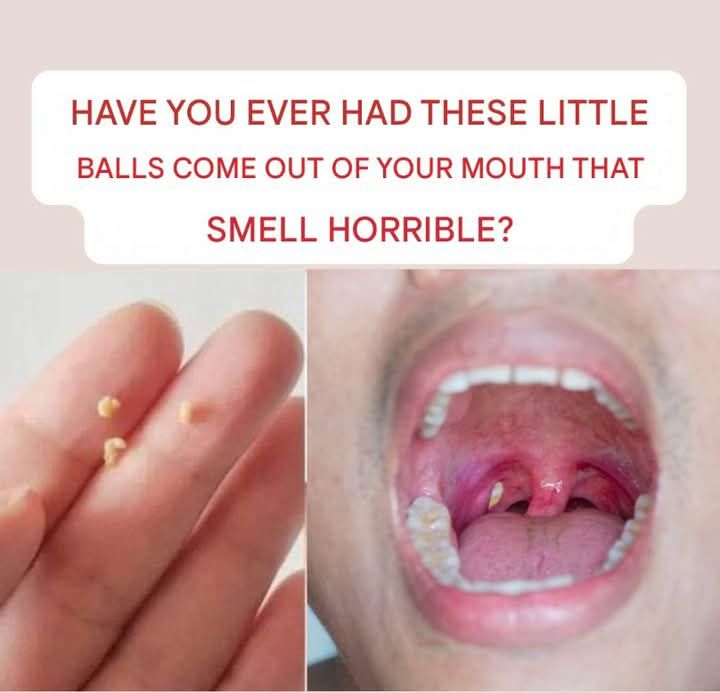
The white or yellow lumps often found on the tonsils are a common phenomenon known as tonsilloliths or tonsillar stones.
If tonsilloliths are recurrent or causing significant problems, it is advisable to consult a doctor or dentist. In some cases, options such as tonsillectomy (removal of the tonsils) may need to be considered.
White or yellow bumps on the tonsils, known as tonsilloliths, are a common but treatable concern. Understanding their causes and how to manage them can help reduce their occurrence and improve quality of life.
Maintaining good oral hygiene is key to preventing their formation and combating the associated bad odor. If you experience persistent problems, do not hesitate to seek medical attention to obtain the appropriate treatment.
Although they may seem harmless, many people are concerned about their presence and the bad smell that often accompanies them, but what are these little balls, their causes, why they generate an unpleasant smell and how they can be treated.
What are tonsil stones?
Tonsilloliths are small formations that occur in the crypts (fissures) of the tonsils. These lumps can vary in size and color, with white or yellow being the most common. Although they are not dangerous, they can cause discomfort and have a negative impact on the oral health and quality of life of those who suffer from them.
– Causes of tonsil stones:
1. Accumulation of waste
One of the main causes of tonsillolith formation is the accumulation of debris in the tonsil crypts. This debris may include food debris, dead cells, mucus and bacteria. When these materials become trapped, they can calcify and form pellets.
2. Recurrent infections
Throat infections, especially tonsillitis, can contribute to tonsillolith formation. During an infection, the tonsils may become inflamed and produce more mucus, increasing the chance of debris building up in their crevices.
3. Poor oral hygiene
Poor oral hygiene is another factor that can facilitate the formation of tonsil stones. Lack of proper brushing and irregular use of dental floss allow bacteria and food debris to accumulate in the mouth, which can lead to the creation of these stones.
4. Changes in bacterial flora
The bacterial flora of the mouth plays a crucial role in oral health. Changes in this flora, whether due to excessive use of antibiotics or diseases, can promote the growth of bacteria that contribute to the formation of tonsilloliths.
5. Anatomical factors
Some people have larger tonsils or tonsils with more crypts than others, which can make them more likely to develop tonsilloliths. Individual anatomy affects how debris collects in the tonsils.
Why do tonsil stones smell bad?
The bad smell associated with tonsil stones is usually caused by the decomposition of materials trapped in the tonsils. The bacteria that develop in this anaerobic (oxygen-free) environment produce volatile compounds that generate an unpleasant odor.
1. Hydrogen sulfide
One of the components responsible for the bad smell is hydrogen sulfide, a gas that is produced during the decomposition of organic matter. This gas has a characteristic smell similar to that of rotten eggs.
2. Other volatile compounds
In addition to hydrogen sulfide, there are other volatile compounds that also contribute to odor, these include methyl mercaptan and other bacterial decomposition products.
How can tonsil stones be cured?
Although tonsil stones do not usually require medical treatment, there are several strategies you can follow to reduce their occurrence and eliminate the associated odor.
Improve oral hygiene
One of the most important steps is to maintain good oral hygiene, this includes:
You should brush your teeth about twice a day.
Floss daily to remove food debris from between your teeth.
Clean your tongue with a scraper or brush to remove bacteria.
2. Mouthwashes
Using antiseptic mouthwashes can help reduce the amount of bacteria in your mouth and decrease the risk of tonsil stones forming, so look for products that contain chlorhexidine or tea tree oil.
3. Adequate hydration
Drinking enough water is essential to keep your mouth hydrated and help remove waste, saliva also plays an important role in the natural cleaning process of the mouth.
4. Avoid irritating foods
Some foods can contribute to the formation of tonsil stones or make the odor worse, so avoid foods with strong odors, such as garlic and onions, as well as dairy products if you notice that they affect your condition.
5. Manual extraction
If tonsil stones are visible and causing discomfort, some people choose to remove them manually with a cotton swab or by using an oral irrigator. However, it is important to be careful not to damage the tonsils or cause infections.
6. Medical consultation
If tonsilloliths are recurrent or causing significant problems, it is advisable to consult a doctor or dentist. In some cases, options such as tonsillectomy (removal of the tonsils) may need to be considered.
White or yellow bumps on the tonsils, known as tonsilloliths, are a common but treatable concern. Understanding their causes and how to manage them can help reduce their occurrence and improve quality of life.
Maintaining good oral hygiene is key to preventing their formation and combating the associated bad odor. If you experience persistent problems, do not hesitate to seek medical attention to obtain the appropriate treatment.